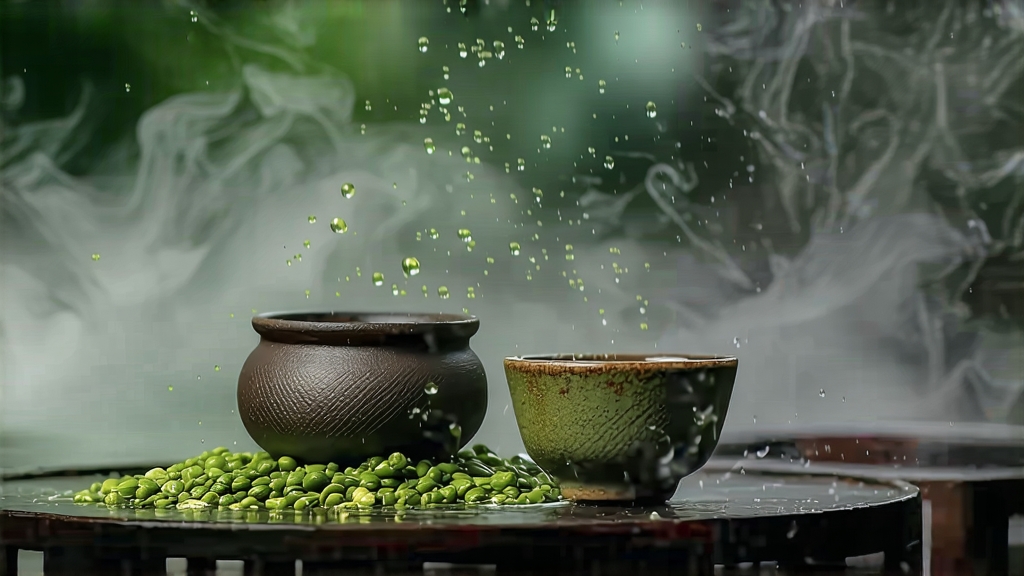
Few leaves carry as much romance, craftsmanship, and sensory drama as Tie Guan Yin, the “Iron Goddess of Mercy.” Born in the granite foothills of Anxi, southern Fujian, this oolong has travelled from hidden temple altars to Parisian cafés, yet it still insists on being leaf-to-leaf coaxed like a shy poet. To understand it is to witness five centuries of Chinese artisanship compressed into one fleeting cup.
-
Historical whispers
Legend sets the origin in the 18th century. A devout farmer named Wei Yin walked daily past a dilapidated Guanyin shrine. One night the goddess appeared in a dream, guiding him to a tiny tea shrub behind the altar. He planted it in his field, nurtured it with almost liturgical care, and the tea’s infusion tasted hauntingly floral, lingering like temple incense. Another version credits the scholar Wang Mang, who discovered the same cultivar near Xiping village. Whichever tale you prefer, the Qing dynasty county annals of Anxi (1725) already list “Tiě Guānyīn” as tribute tea, reserved for imperial inspectors travelling the Minnan trade route. By the late 19th century, Fujianese migrants carried cuttings to Taiwan and to the mountains of northern Thailand, creating diasporic offshoots that still bear the same name but speak in different accents. -
Terroir: why Anxi tastes like morning mist
Anxi County sits on the Tropic of Cancer, 300–800 m above sea level. Granite bedrock weathers into acidic red soil laced with minerals; day-night temperature swings of 10 °C slow the leaf’s growth, condensing amino acids and aromatics. The famous micro-climates are further sculpted by fog from the Jinsha and Xijiang rivers. Locals joke that even the moonlight in Anxi carries jasmine. Eleven designated townships—Xiping, Gande, Longjuan, etc.—are legally protected as “Original Place Tie Guan Yin,” a status akin to Champagne in France. -
Cultivar genealogy
The mother bush is Camellia sinensis var. sinensis, strain “Tie Guan Yin.” It has a medium-sized, oval leaf, thick cuticle, and an unusually high ratio of unsaturated fatty acids—partly why it can endure the violent tossing that defines oolong making. Over centuries, clonal selection produced sub-strains:- Red Heart Tie Guan Yin (old bush, low yield, orchid fragrance)
- Green Heart Tie Guan Yin (modern high-yield, greener liquor)
- White Heart (rare, pale buds, milky notes)
Each strain is further shaped by season (spring water vs. autumn fragrance) and by the farmer’s intent.
-
Craft: the choreography of half-fermentation
Unlike green tea (no fermentation) or black tea (full oxidation), Tie Guan Yin hovers at 25–40 % oxidation, a margin measured by intuition, not clock. The dance begins at dawn: only the top three leaves and the unopened bud are plucked before the mountain sun intensifies.
Step 1: Sun withering (萎凋)
Leaves are spread on bamboo screens for 15–30 min; the goal is to lose about 10 % moisture while waking up enzymes.
Step 2: Cooling (晾青)
Screens are moved indoors; the leaf temperature drops, cell walls loosen, and grassy volatiles evaporate.
Step 3: Tossing (做青)
In a room scented like cut apples, masters hurl the leaves into the air, letting them slap against screens. Micro-ruptures trigger oxidation at the edges while the veins stay green. This step is repeated up to six times across the night; the farmer listens for a rustle that sounds like “rain on silk.”
Step 4: Fixation (杀青)
A 280 °C wok for 3–5 min halts oxidation, locking in the signature “ring of iron” around the leaf rim.
Step 5: Rolling & shaping (揉捻/包揉)
Unlike strip-shaped Wuyi oolongs, Tie Guan Yin is wrapped in a square of cotton cloth, twisted into a ball, and gently rolled under foot or mechanical press. The cycle—wrap, roll, unwrap, re-wrap—repeats 30–40 times over two hours, compacting the leaf into the iconic “dragonfly head, frog leg” nugget.
Step 6: Baking (烘焙)
Traditional charcoal